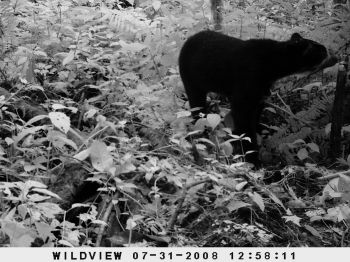Broadcast: News items
Caught on camera: the rainforest’s endangered animals
By: James Hakner
Last updated: Friday, 3 July 2009

A spectacled bear, caught on camera in the Ecuadorean rainforest
Rarely seen and endangered mammals such as the spectacled bear and jungle big cats will soon be captured for the world to view - on camera, that is - thanks to an innovative project involving the University of Sussex and internet giants Google.
The animals under scrutiny live in the north-west Ecuadorean rainforest in South America - a diversity hotspot with more mammals than anywhere else on earth, but which is under threat from logging and the effects of climate change.
Dr Mika Peck has been working on conservation projects in the Santa Lucia Cloudforest Reserve for several years. He says: "There is an urgent need to assess the status of endangered species to see whether the current network of protected forests is successful in conserving biodiversity, particularly the larger mammal species that need particular types of habitat and larger areas to roam in."
To monitor these animals and to build a picture of the rainforest's general health, Mica and his fellow conservationists are using motion-sensitive digital-camera traps that film endangered species in difficult-to-access habitats.
The information is sent via the internet, using a solar-powered laptop and a mobile broadband connection in the reserve lodge, to an online database managed by Computing and Electronic Services Manager Brian Warburton in Life Sciences.
With help from Google Maps, the public will be able to view the images and keep track of species via the web site of charity Rainforest Concern.
Mika says: "The link to Google allows us to spy on this remote rainforest from the comfort of our homes. We might even get to see something completely unexpected. The images already collected in a trial run in 2008 inspired wonder and surprise even among locals, as these large mammals are rarely seen even by them in the dense forest."
Mika has been helping to create alternative sustainable livelihoods to hunting and logging, such as small-scale ecotourism. Through this latest project, tourists could soon be trekking into the jungle with local workers to collect memory cards from the camera traps, providing income from tourism and jobs for the local population.
Mika says: "We hope the project will run for at least 10 years and that it will start to pay for itself as people visit the reserve to help with the data collection as part of a 'scientific eco-holiday'."
He adds: "The long-term storage of this type of information means we can follow what happens to these species as we try to engage in their conservation."

